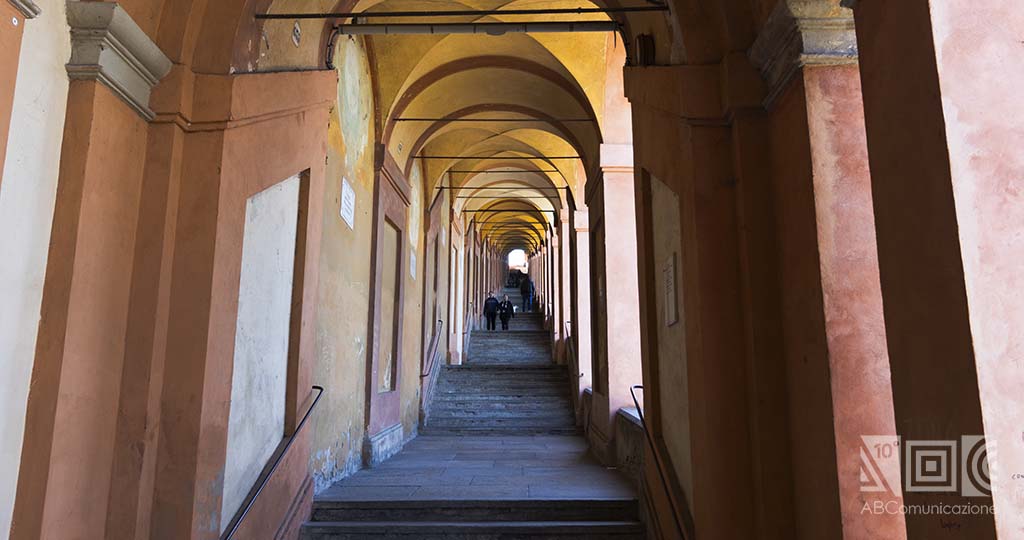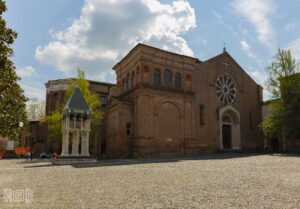Do you want to know the history and curiosities about the Sanctuary of the Madonna of San Luca? Then you are in the right place, come with us to discover it!
The legend of the Sanctuary of the Madonna of San Luca
The Sanctuary of the Madonna of San Luca is located on the Colle della Guardia, outside the historic center of Bologna.

The birth of the Sanctuary of the Madonna of San Luca is tied to a legend. It is said that in 1160 a pilgrim, the Greek Teocle Kmynia, had received the painting of the Madonna with Child made by the evangelist Luke in the church of Santa Sofia in Constantinople; according to the writing on the canvas, the pilgrim had to take it to the church of the Colle della Guardia.
When Teocle Kmynia arrived in Rome, he met a Bolognese senator who showed him the way.
Once reached Bologna in 1160, the pilgrim was welcomed into the city and the painting was carried in procession to the top of the Colle della Guardia, in the church that would become, after various transformations, the Sanctuary of the Madonna of San Luca.
At the foot of the Guardia hill, in addition to the monumental Cemetery of the Certosa, there is also the garden of Villa Spada, one of the most beautiful historic villas in Bologna!
The Sanctuary of the Madonna of San Luca today
Although the legend dates back the origin of the Sanctuary of the Madonna of San Luca to the XII century, the building that we can admire today dates back to 1700, with changes and renovations carried out in the following years.
Its creation is due to a woman, Angelica Bofantini, who built the first church dedicated to the Madonna of San Luca and which will later be transformed into the current Sanctuary of the Madonna of San Luca.
The exterior, in Baroque style, is characterized by the color orange, typical of Bolognese buildings. The dome of the Sanctuary of the Madonna of San Luca can be visited and from its panoramic terrace it is possible to see a breathtaking view over the whole city of Bologna. Inside you can see some altarpieces made by very famous artists such as Guido Reni and Donato Creti.

The Madonna of San Luca is kept inside a silver-plated copper case: it is necessary to protect the painting from atmospheric agents and the passage of time. The last restoration took place a few years ago to clean up the painted image and to give brightness to the case. The last time the case was opened was about 40 years ago.
The Sanctuary of the Madonna of San Luca is a pilgrimage site for believers, but it is also a very popular tourist destination.
A curiosity that few people know is that its ascent is equivalent to a small sacrifice for the Bolognese. It is said that reaching the Sanctuary of the Madonna of San Luca by foot can make a wish come true.
In 2019 the Sanctuary of the Madonna of San Luca was nominated a UNESCO World Heritage Site. Do you know that the arcades of Bologna have become a UNESCO World Heritage Site? Find out more in the article The porticoes of Bologna: UNESCO World Heritage.
Do you want to know more about the portico that reaches the top of the Sanctuary of the Madonna of San Luca? Find it out with us!
The longest portico in the world
The Sanctuary of the Madonna of San Luca is located at the end of the portico that begins in St. Saragozza, named the longest in the world with its 3796 meters.

The curiosities about the portico did not end here. We have already talked about the Seven Secrets of Bologna (see also the article A journey through the Seven Secrets of Bologna), but those listed are certainly not the only parts of the city covered by a halo of mystery and legend!
In fact, the portico that reaches the Sanctuary of the Madonna of San Luca is also known for having 666 arches, a controversial number when we talk about religious themes, as it would represent Satan. That is the secret of San Luca: it is thought that the intricate portico represents the serpent-devil, crushed by the Madonna, represented by her sanctuary.
But who built the portico?
Originally, there was only a footpath on which it was possible to see lots of images of the Madonna along the way. To protect these artworks, in 1650, the long portico was designed and built, thanks to the loan of merchants and wealthy families.
Along the way to the Sanctuary of the Madonna of San Luca 15 chapels were created that contain the Mysteries of the Rosary and lunettes to honor the coats of arms of the families that participated in the loan.
The miracles of the Sanctuary of the Madonna of San Luca
The Sanctuary of the Madonna of San Luca is a very important place for Catholics and since centuries it has become a destination for pilgrims.
The sacredness of the Sanctuary of the Madonna of San Luca is, in part, due to two miracles that are believed to have occurred thanks to the image kept in the basilica: the “miracle of the rain” and the one of the Venetian merchants.

The miracle of rain dates back to July 1433, when the incessant rain of that period was ruining the harvest, bringing the risk of a famine. Therefore it was decided to organize a procession, carrying the image of the Madonna with Child in the center of Bologna: that day the rain stopped and the sun began to shine. From this episode was born the traditional procession that is organized every year on that day. It is a spring festival, in which the image of the Madonna remains exhibited for a week in the cathedral of San Pietro.
Do you want to find out more about the cathedral of San Pietro ? Do not miss the article The Metropolitan Cathedral of San Pietro in Bologna: what’s to know?
Another miracle is the one that tells the story of some merchants from Venice who stole the image of the Madonna with Child. According to the legend, the icon disappeared from the box in which it was placed to be transported, but suddenly reappeared on the Colle della Guardia.
The cable car to the Sanctuary of the Madonna of San Luca
Although there was already the porch that connected Bologna to the Sanctuary of the Madonna of San Luca, in 1888 the first proposal for the construction of a cable car was presented in order to make the climb less tiring.
It was not until 1931, thanks to the engineer Ferruccio Gasparri, student and professor at the University of Bologna, that the Bologna-San Luca cable car was built. In a few months it became the busiest cable car in Italy.
The climb started from the valley station, located in St. Porrettana near the beginning of St. Andrea Costa. The maximum number of people who could go up was 20 and each ride lasted about 6 minutes.
Once you arrive at the mountain station, you could see the amazing panorama of the Sanctuary of the Madonna of San Luca, the restaurant “La Funivia” and some salesman of candied fruit and souvenirs.

In 1948, due to a bomb, two cabins fell: the collapse also ruined the ropes and therefore the races were interrupted.
However, after World War II, public and private transport increased thanks to economic growth and the introduction of the injection engine. There were few people who still used the cable car so, due to its low income and high living costs, it was forced to close.
The official closure of the cable car took place in 1976 when, outside the station, a sign was placed indicating the closure for maintenance, but in reality it would never re-open.
You can still see the valley station which, after various modifications, has been transformed into an apartment building. The mountain station and its original pillar can also be seen from Casalecchio.
If you want to stop for a short break, we recommend the Cremeria Funivia: an ice cream parlour that is located next to the valley station of the old cablecar. There you can try tasty ice creams of various flavors, even the most sought ones, created by the staff of Leonardo Ragazzi, the founder.
How can I get to the Sanctuary of the Madonna of San Luca?
The Sanctuary of the Madonna of San Luca can be reached by foot or through the use of the train or the car.
If you want to try to walk the porch, you have to go to the Saragozza district, more precisely to the arco del Meloncello. From there, you won’t lose the way: the porch and its long staircase will lead you to the top of the Sanctuary of the Madonna of San Luca.
You can also choose to use the car or the train to get to the top.
For those who choose to get in the car, it is necessary to take the St. Saragozza and turn on St. di Casaglia that through a panoramic route will lead you to the Sanctuary of the Madonna of San Luca.
Finally, you can also reach the Sanctuary by San Luca Express train, active only on Saturdays and Sundays, departing from Piazza Maggiore, stopping on request also from Piazza Malpighi.
The cost is 10€ for adults, 5€ for children (6-10 years), disabled and their companions; 3€ for children from 0 to 5 years.

In addition, if you are into paths and excursions read also our article about the Via degli Dei, an itinerary that passes through the Basilica of San Luca.
Once you are in Piazza Maggiore waiting for the train, why not also visit the wonderful covered square Umberto Eco, inside the Salaborsa Library, which once was also the seat of the Botanical Garden of Bologna, now in Via Irnerio 42? Then, do not miss the Basilica of San Petronio, and a few meters away you will also find the charming Basilica of Santo Stefano.
When can I visit the Sanctuary of the Madonna of San Luca?
The Sanctuary of the Madonna of San Luca is open daily from 7 am to 6:30 pm. During the months between March and October, the closure is postponed to 19:00. Admission is free.
The cost to visit the panoramic terrace is 5€ for adults; 3€ for over-65s, children from 10 to 18 years old and school children; the visit is free for children under 10 years old, people with disabilities, guides and journalists with ID and finally Bologna Welcome Card holders.
Bibliography:
- Costa T., Bologna dalla A alla Z, Bologna, Costa Editore, 2011
- Degli Esposti C., Il santuario della Madonna di San Luca e il suo portico, Bologna, Persiani editore, 2012
- Ingenni P., La Funivia Bologna – San Luca 1931 – 1976, CreateSpace, 2018
- Menarini A., Vianelli A., Leggende e curiosità, Bologna, Tamari Editori, 1973




